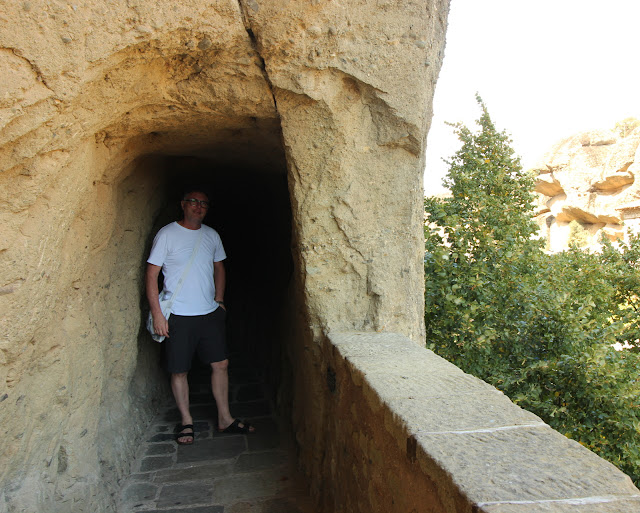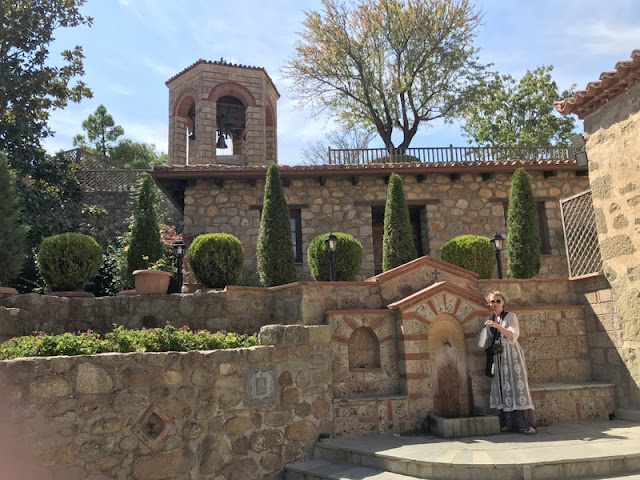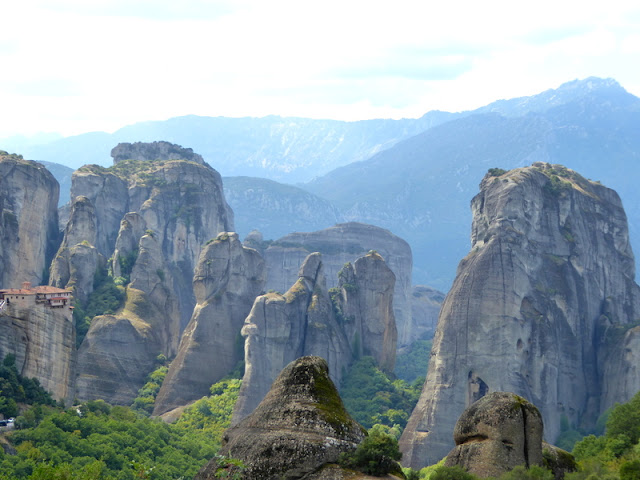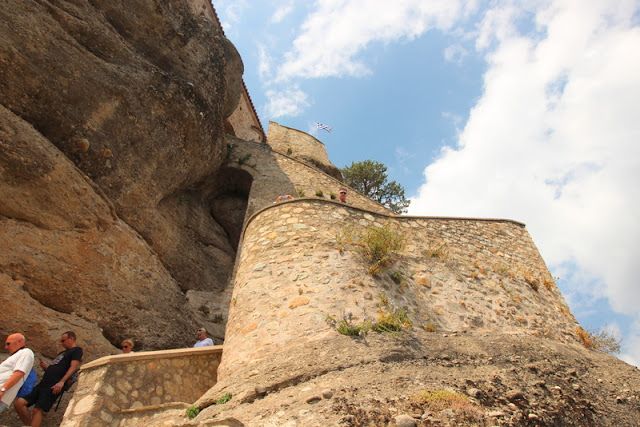a change of plan, hitching a ride
and the biggest, oldest monastery of them all
a change of plan, hitching a ride
and the biggest, oldest monastery of them all
written by Krystene Vickers
Meteora's giant rock formations soar in grandeur around me, as I linger on our balcony trying to memorise this jaw-dropping view. Everything is quiet and still, except for a cat stealthily making its way along a garden wall below me. It is our last day here in Kastraki and I'm a little sad.
Today we are heading to the Monastery of St. Nikolaos Anapafsas, a mere 1km
away. A short stroll for us two-day hiking veterans of Meteora. We wander down
through the now familiar streets of Kastraki. The stone wall of a tiny chapel glows
warmly in the morning sun and the village square is effused with golden light as
the sun filters through its autumn coloured trees. All against the ever-present
backdrop of ancient cliffs silhouetted against the morning sky. A tiny part of our
minds still telling us this can't be real. There is such an otherworldly feel here,
the juxtaposition of everyday life against these dramatic landforms is quite
literally mind-boggling.
We make our way past the local school, to the sound of children playing, and
up the hill beyond. Trees casting long shadows and dappled light as the world
wakes to a fresh new day. Soon the monastery appears enticingly before us,
its stone walls like a natural extension of the cliff itself. The building dwarfed
by the massive rock range directly behind it; upon which the morning sun
casts beautiful light and shadow in the vertical and horizontal crevices.
A couple of hikers pass by going the other way. Fellow Meteora travellers,
pilgrims even. We're both feeling very fit and able after all our trekking; two
50-something’s totally sussing it. So we just have to laugh when we arrive
at the monastery a short while later; the gate securely shut with a sign saying:
closed on Fridays. Not quite so sussed after all, and now sad to have missed out
on seeing this monastery.
pilgrims even. We're both feeling very fit and able after all our trekking; two
50-something’s totally sussing it. So we just have to laugh when we arrive
at the monastery a short while later; the gate securely shut with a sign saying:
closed on Fridays. Not quite so sussed after all, and now sad to have missed out
on seeing this monastery.
Pondering our next move, we sit on a bench sipping water and eating humble
pie, a couple of unsuspecting tourists pull up in their rental car beside us.
A lady steps out and walks over. Seeing my opportunity, I point to the sign,
explain the monastery is closed today, asking where they will head next and
if they would mind giving us a lift. She checks with her son, waiting in the
driver's seat, and beckons us over.
pie, a couple of unsuspecting tourists pull up in their rental car beside us.
A lady steps out and walks over. Seeing my opportunity, I point to the sign,
explain the monastery is closed today, asking where they will head next and
if they would mind giving us a lift. She checks with her son, waiting in the
driver's seat, and beckons us over.
Luxuriating in the air conditioning we are chauffeur driven up to the tiny
Roussanou Monastery we visited the day before. Across the gully, the sight of
Varlaam Monastery beckons once again. Thanking our rescuers, we set out
along yesterdays route, only this time bound for the biggest monastery of them
all: The Great Meteoron, just beyond Varlaam.
Roussanou Monastery we visited the day before. Across the gully, the sight of
Varlaam Monastery beckons once again. Thanking our rescuers, we set out
along yesterdays route, only this time bound for the biggest monastery of them
all: The Great Meteoron, just beyond Varlaam.
 |
| Roussanou Monastery (left) and Varlaam Monastery (right) |
although today we feel less like visitors and more a sense of belonging somehow.
There is something about this place that draws you. It is easy to understand why
holy men chose to stay here. We walk together quietly lost in our own thoughts,
breathing in each moment of our last day.
 |
| Varlaam Monastery |
As we near a fork in the road, modern life brings us back to the present once
again. It is no less busy than yesterday and we realise how privileged we have
been experiencing the Holy Trinity and Roussanou monasteries from the quiet
solitude of the hiking trails. Ilias our taxi driver for the sunset last night, told
us many people only spend a few hours in Meteora before returning to Athens.
We are grateful to have had the time to immerse ourselves a little more in this
magical place: the people, history, art, architecture, and incredible landscape.
Ignoring the traffic, we walk on up the hill toward The Great Meteoron Monastery,
pausing regularly to enjoy the stunning views back to the Monastery of Varlaam.
 |
| looking back at Varlaam Monastery |
and clusters of tourists; some browsing the ubiquitous tent selling tourist tat.
Yes, there were ones outside Varlaam & St Stephen monasteries too, but
thankfully none of the others. After grabbing an ice cold drink, we find a pozzie
under a tree, in a little courtyard to the left, and watch all the people ascend the
stairs zig-zagging up the cliff opposite, like a procession of colourful ants. A
myriad of languages filling the air.
I really can’t emphasize enough how unique and impressive the approach to
each of these monasteries are. Until 1929, the only way to enter or exit was on
precarious wooden ladders hung vertically down a vast rock face, or in rope
baskets hoisted up to a timber platform cantilevered out from the monastery itself.
Seriously scary stuff! These monks were brave souls. Although I cannot imagine
how they negotiated those ladders in their long robes. These and other important
questions flit through my mind. 'Perhaps they wore different clothes for that?' I
mention out loud. Rod suggests I may be over thinking this.
Some of the monasteries have lift-sized boxes suspended from cables, travelling
across from a cliff opposite. Like a rudimentary cable car. Just now, a car comes
into view, silhouetted against the vivid blue sky high above us. It is an open box;
a man standing nonchalantly within, as it slowly makes its way across the ravine
miles below. Brave souls indeed!
each of these monasteries are. Until 1929, the only way to enter or exit was on
precarious wooden ladders hung vertically down a vast rock face, or in rope
baskets hoisted up to a timber platform cantilevered out from the monastery itself.
Seriously scary stuff! These monks were brave souls. Although I cannot imagine
how they negotiated those ladders in their long robes. These and other important
questions flit through my mind. 'Perhaps they wore different clothes for that?' I
mention out loud. Rod suggests I may be over thinking this.
Some of the monasteries have lift-sized boxes suspended from cables, travelling
across from a cliff opposite. Like a rudimentary cable car. Just now, a car comes
into view, silhouetted against the vivid blue sky high above us. It is an open box;
a man standing nonchalantly within, as it slowly makes its way across the ravine
miles below. Brave souls indeed!
Safely down at ground level, seeing a strategic gap in the continuous stream
of visitors, we brave the stairs, head across a flagstone path and then up more
stairs to a solitary ancient studded timber door set into the face of the cliff.
Inside we find ourselves in a cave with a tiny little shrine niche to one side.
The base covered in little prayer papers. On through a narrow passageway hewn
in the rock, we emerge once again into the bright sunshine and begin the steady
climb, single file, up the stairs beyond. Stopping often, not because we are puffed
(honest) but to gaze at the view. The scenery alone is epic (and I don't use the
word lightly), let alone the monasteries themselves; what a feat of construction
perched atop these giant rock formations! Even amidst all the people, its
magnificent presence dominates our consciousness.
of visitors, we brave the stairs, head across a flagstone path and then up more
stairs to a solitary ancient studded timber door set into the face of the cliff.
Inside we find ourselves in a cave with a tiny little shrine niche to one side.
The base covered in little prayer papers. On through a narrow passageway hewn
in the rock, we emerge once again into the bright sunshine and begin the steady
climb, single file, up the stairs beyond. Stopping often, not because we are puffed
(honest) but to gaze at the view. The scenery alone is epic (and I don't use the
word lightly), let alone the monasteries themselves; what a feat of construction
perched atop these giant rock formations! Even amidst all the people, its
magnificent presence dominates our consciousness.
Up a final massive flight of stairs, we enter into the delightfully cool dimness
of the main entry and purchase our tickets; receiving a lovely smile and “Parakaló”
response to our “efcharistoúme”. Our pronunciation may be improving?
Beyond we find the largest complex of monastic buildings we have seen so far,
with many levels, courtyards, gardens and a wide-open terrace with stunning views
out to Varlaam, Roussanou and the village of Kastraki far below. The realisation of
how high up we are sinks in. We take time to enjoy the views from every direction,
strategically avoiding the odd person with a selfie stick (deliberate play on words),
before venturing inside.
of the main entry and purchase our tickets; receiving a lovely smile and “Parakaló”
response to our “efcharistoúme”. Our pronunciation may be improving?
Beyond we find the largest complex of monastic buildings we have seen so far,
with many levels, courtyards, gardens and a wide-open terrace with stunning views
out to Varlaam, Roussanou and the village of Kastraki far below. The realisation of
how high up we are sinks in. We take time to enjoy the views from every direction,
strategically avoiding the odd person with a selfie stick (deliberate play on words),
before venturing inside.
Here we discover that with a small amount of patience and a fair amount of time
to spare, it is possible to experience this monastery without a throng a people
constantly around you. Although it lacks the quiet tranquility of the others, its
sheer size enables us to quietly explore every aspect in between the crowded
moments. Of all the monasteries, this one has the most diverse array of historical
artifacts, and a strong sense of time encapsulated through the ages. Not only
is it the largest monastery, it is also the oldest still in use today.
There is so much to see here, in so many different spaces within the complex.
The main cathedral adorned with remarkable frescoes and exquisite furniture.
Museums with icons, ancient texts, monks robes and accessories, all in amazingly
good condition and beautifully displayed. An original kitchen, full of furniture,
devices and cooking utensils used down through the ages. Black and white
photographs, a comprehensive timeline and a huge display of building tools,
garden and farming equipment, give us a vivid insight into the former monks'
way of life.
Fortunately, there are also plenty of quiet places to sit and contemplate everything
we are seeing. Some hours later, as we traverse the dramatic stair and tunnel
down we discuss how awesome it is, despite all the turbulent times humankind
has faced in the last 800 years, these monastic communities have managed to
survive; safeguarding these precious gems and providing us with a rich and
tangible link with the past.
tangible link with the past.
 |
| Hotel Pyrgos Adracht, Kastraki |
 |
| Jaw-dropping view from our bedroom balcony |
Meteora is a place everyone should experience at least once in their lifetime.
But please, not all at once. It would be a shame to overcrowd this truly unique
treasure.











































